APQC知识管理实施手册
- 格式:doc
- 大小:63.50 KB
- 文档页数:41
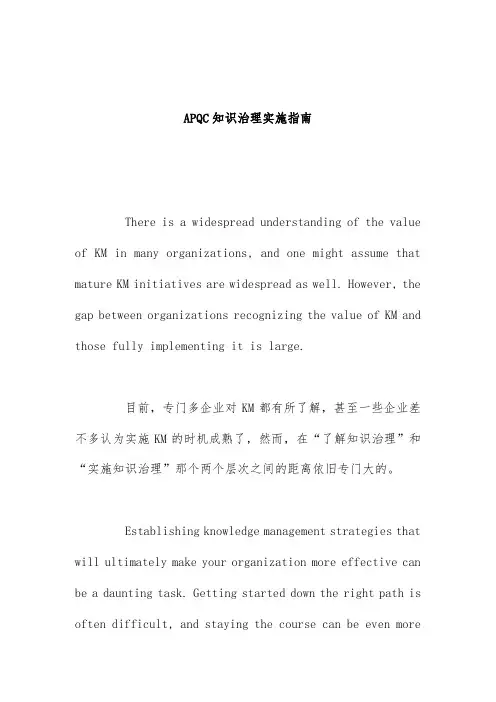
APQC知识治理实施指南There is a widespread understanding of the value of KM in many organizations, and one might assume that mature KM initiatives are widespread as well. However, the gap between organizations recognizing the value of KM and those fully implementing it is large.目前,专门多企业对KM都有所了解,甚至一些企业差不多认为实施KM的时机成熟了,然而,在“了解知识治理”和“实施知识治理”那个两个层次之间的距离依旧专门大的。
Establishing knowledge management strategies that will ultimately make your organization more effective can be a daunting task. Getting started down the right path is often difficult, and staying the course can be even moreso as roadblocks spring up in your way. Although you may see KM as a worthwhile effort, convincing others of its value and making it happen across your organization can be a tall order.建立知识治理的战略以保持企业的活力是一件特不困难的情况,第一步选对方向就更加困难了,整个实施过程到处充满了绊脚石。
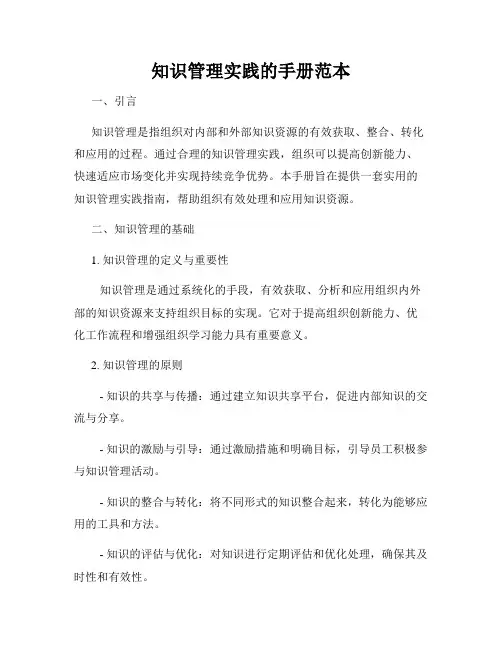
知识管理实践的手册范本一、引言知识管理是指组织对内部和外部知识资源的有效获取、整合、转化和应用的过程。
通过合理的知识管理实践,组织可以提高创新能力、快速适应市场变化并实现持续竞争优势。
本手册旨在提供一套实用的知识管理实践指南,帮助组织有效处理和应用知识资源。
二、知识管理的基础1. 知识管理的定义与重要性知识管理是通过系统化的手段,有效获取、分析和应用组织内外部的知识资源来支持组织目标的实现。
它对于提高组织创新能力、优化工作流程和增强组织学习能力具有重要意义。
2. 知识管理的原则- 知识的共享与传播:通过建立知识共享平台,促进内部知识的交流与分享。
- 知识的激励与引导:通过激励措施和明确目标,引导员工积极参与知识管理活动。
- 知识的整合与转化:将不同形式的知识整合起来,转化为能够应用的工具和方法。
- 知识的评估与优化:对知识进行定期评估和优化处理,确保其及时性和有效性。
三、知识管理的实施步骤1. 知识需求识别针对组织需求,了解关键知识领域和痛点,并确定知识管理的优先级和范围。
2. 知识获取与整合- 内部知识获取:通过员工培训、协作机制等手段,获取组织内部的专业知识。
- 外部知识获取:通过参与行业会议、合作伙伴交流等方式,获取外部知识资源。
- 知识整合:将获取的知识进行整理、分类和编目,建立知识库或知识图谱。
3. 知识传播与分享- 知识共享平台:建立内部专业社区、在线论坛等平台,促进员工之间的知识交流和分享。
- 知识分享方式:通过员工培训、经验分享会、内部演讲等形式,传播和分享知识。
4. 知识应用与创新- 知识应用:将知识应用到具体的业务流程中,提高工作效率和质量。
- 知识创新:鼓励员工提出创新建议,培养创新意识和能力,推动知识创新。
5. 知识评估与优化建立知识评估机制,对知识内容、形式和传播方式进行评估,并不断优化知识管理系统。
四、知识管理的关键要素1. 技术支持建立适合组织需求的知识管理系统,提供方便、高效的知识获取、存储和传播工具。
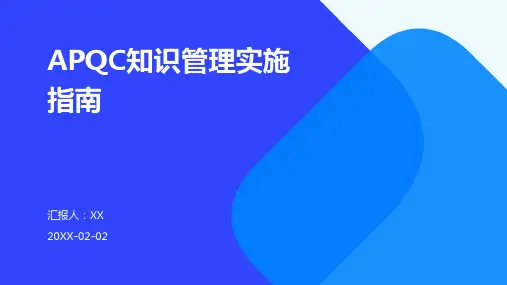
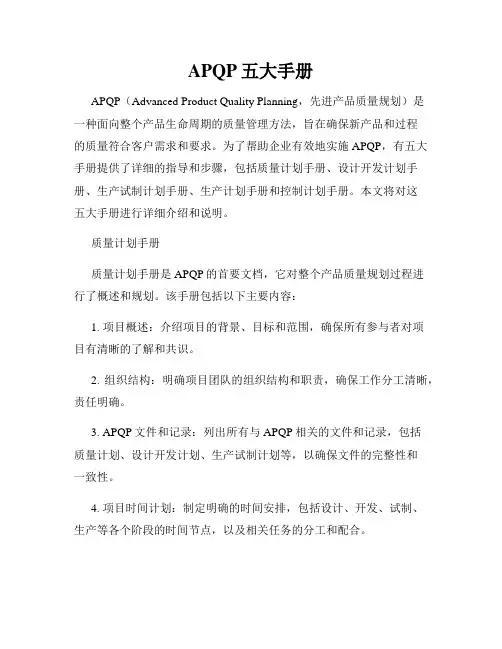
APQP五大手册APQP(Advanced Product Quality Planning,先进产品质量规划)是一种面向整个产品生命周期的质量管理方法,旨在确保新产品和过程的质量符合客户需求和要求。
为了帮助企业有效地实施APQP,有五大手册提供了详细的指导和步骤,包括质量计划手册、设计开发计划手册、生产试制计划手册、生产计划手册和控制计划手册。
本文将对这五大手册进行详细介绍和说明。
质量计划手册质量计划手册是APQP的首要文档,它对整个产品质量规划过程进行了概述和规划。
该手册包括以下主要内容:1. 项目概述:介绍项目的背景、目标和范围,确保所有参与者对项目有清晰的了解和共识。
2. 组织结构:明确项目团队的组织结构和职责,确保工作分工清晰,责任明确。
3. APQP文件和记录:列出所有与APQP相关的文件和记录,包括质量计划、设计开发计划、生产试制计划等,以确保文件的完整性和一致性。
4. 项目时间计划:制定明确的时间安排,包括设计、开发、试制、生产等各个阶段的时间节点,以及相关任务的分工和配合。
5. 风险管理计划:对项目可能出现的风险进行评估和管理,制定相应的措施和应对计划,以降低风险对产品质量的影响。
设计开发计划手册设计开发计划手册是APQP中的第二个重要文档,它旨在确保产品在设计和开发阶段能够满足客户的质量要求。
该手册包括以下内容:1. 设计和开发目标:明确产品的设计和开发目标,包括外观、性能、功能等方面的要求。
2. 工程参数和规范:定义产品的工程参数和技术规范,确保设计和开发过程中遵循相应的标准和要求。
3. 设计验证计划:制定产品设计验证的计划和方法,包括模型测试、样品测试等,以确保产品设计的准确性和可行性。
4. 设计变更控制计划:规定产品设计变更的控制流程和程序,包括变更申请、评审、批准等,以确保变更对产品质量的影响得到控制。
5. 设计评审和发布计划:制定设计评审和发布的时间计划和流程,包括设计评审会议、设计变更通知等,以确保设计在符合要求的情况下得到及时审查和发布。
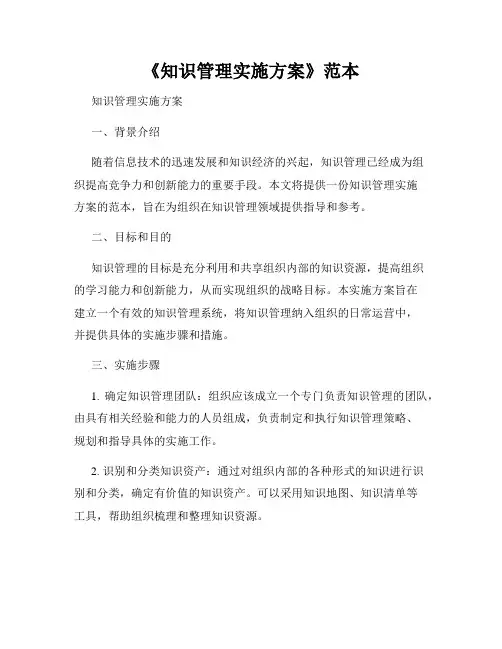
《知识管理实施方案》范本知识管理实施方案一、背景介绍随着信息技术的迅速发展和知识经济的兴起,知识管理已经成为组织提高竞争力和创新能力的重要手段。
本文将提供一份知识管理实施方案的范本,旨在为组织在知识管理领域提供指导和参考。
二、目标和目的知识管理的目标是充分利用和共享组织内部的知识资源,提高组织的学习能力和创新能力,从而实现组织的战略目标。
本实施方案旨在建立一个有效的知识管理系统,将知识管理纳入组织的日常运营中,并提供具体的实施步骤和措施。
三、实施步骤1. 确定知识管理团队:组织应该成立一个专门负责知识管理的团队,由具有相关经验和能力的人员组成,负责制定和执行知识管理策略、规划和指导具体的实施工作。
2. 识别和分类知识资产:通过对组织内部的各种形式的知识进行识别和分类,确定有价值的知识资产。
可以采用知识地图、知识清单等工具,帮助组织梳理和整理知识资源。
3. 构建知识共享平台:建立一个全员参与的知识共享平台,利用互联网和内部信息系统,促进知识的交流和共享。
可以通过建立在线论坛、专家咨询系统、博客等方式,鼓励员工积极分享和传播知识。
4. 建立知识库和学习资源中心:将组织内部的知识资料、学习资源等收集整合起来,建立一个可供员工学习和借鉴的知识库和学习资源中心。
可以采用文档管理系统、电子图书馆等工具,提供便捷的获取和共享渠道。
5. 培养知识管理能力:组织应该注重对员工的知识管理能力进行培养和提升。
可以通过组织内部的培训、知识分享会、外部培训等方式,提高员工的知识获取、整理、分享和应用的能力。
6. 持续改进和评估:知识管理应该是一个持续改进的过程。
组织应该设立评估指标和周期,定期对知识管理的成效进行评估和反馈,及时调整和优化知识管理策略和措施。
四、实施要点1. 领导支持和积极参与:知识管理需要得到组织高层的支持和重视,领导应该发挥榜样作用,积极参与到知识管理活动中。
2. 建立激励机制:组织可以通过建立知识贡献奖励制度、知识分享比例考核等方式,激励员工积极参与知识管理活动。
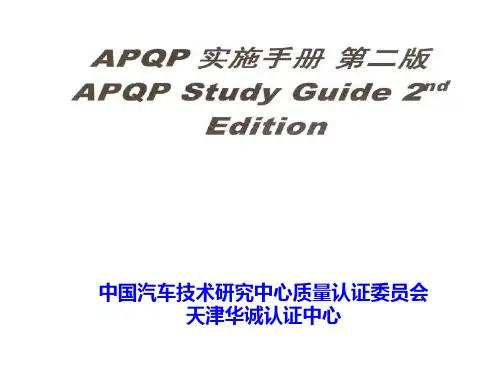
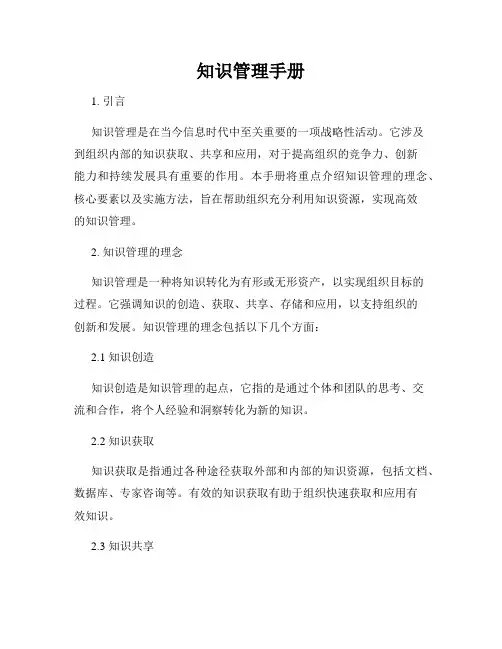
知识管理手册1. 引言知识管理是在当今信息时代中至关重要的一项战略性活动。
它涉及到组织内部的知识获取、共享和应用,对于提高组织的竞争力、创新能力和持续发展具有重要的作用。
本手册将重点介绍知识管理的理念、核心要素以及实施方法,旨在帮助组织充分利用知识资源,实现高效的知识管理。
2. 知识管理的理念知识管理是一种将知识转化为有形或无形资产,以实现组织目标的过程。
它强调知识的创造、获取、共享、存储和应用,以支持组织的创新和发展。
知识管理的理念包括以下几个方面:2.1 知识创造知识创造是知识管理的起点,它指的是通过个体和团队的思考、交流和合作,将个人经验和洞察转化为新的知识。
2.2 知识获取知识获取是指通过各种途径获取外部和内部的知识资源,包括文档、数据库、专家咨询等。
有效的知识获取有助于组织快速获取和应用有效知识。
2.3 知识共享知识共享是指组织成员之间的知识交流与分享,通过建立协作平台、知识库和社交网络等方式,促进知识的共享和传递。
2.4 知识存储知识存储是指将各种形式的知识储存起来,包括文档、数据库、内部报告等。
合理的知识存储有助于组织成员快速查找和使用知识。
2.5 知识应用知识应用是指将知识转化为实际行动,支持组织目标的实现。
有效的知识应用可以提高组织的创新能力和竞争力。
3. 知识管理的核心要素要实施有效的知识管理,需要重视以下几个核心要素:3.1 领导力支持知识管理需要组织领导的支持和引领。
领导者应该建立全员参与的知识文化,鼓励员工积极创造新知识,主动分享和应用知识。
3.2 信息技术支持信息技术是知识管理的重要支撑。
组织应该投资并利用合适的信息技术工具,构建知识管理平台,提供知识获取、共享和存储的功能。
3.3 组织学习与培训组织学习和培训是知识管理的重要手段。
组织应该鼓励员工参与学习和培训活动,不断提升员工的知识和技能水平。
3.4 绩效评估与激励机制绩效评估和激励机制可以促进知识管理的有效实施。

序号0级1级2级3级4级101愿景和战略21定义业务概念和长期愿景31评估外部环境41 分析和理解竞争52 识别经济趋势63 识别政治和监管74 评估技术创新85 理解人口因素96 识别社会和文化107 理解生态相关因112调查市场并识别客户需求121 开展定性/定量分132 采集和评估客户14要进入的市场154开展内部分析161 分析组织特性172 描述现有流程基183 对系统和技术进行分析194 分析财务定位205 识别企业核心竞215建立企业愿景221 使利益相关人对战略愿景达成一致232制定业务战略241制定整体使命描述25战略备选方案263对购并/收购/剥离战略进行设计和管理274制定全公司的品牌战略285制定知识管理战略291 识别所有关键职能领域的知识管理302 设计一个在核心职能领域进行知识管理的业313 识别出公司和业务单元在知识管理方面的不32架构设计、安排组织单元之间的关系337设计并设定组织目标348阐明业务单元战略353管理起步战略361设计起步战略372评估起步战略38起步战略394确定高阶战略4002产品/服务研发411产品/服务421新产品/服务的战略和概念制定431 调研客户和市场442 设计开发成本和质量目标453 勾画产品生命周期并界定其中各期时间长度464 调研领先的技术、构件和研发需求47新产品/服务,评估和改进已有产品/服务481 将客户需求转变为产品和/或服务需492 产生新产品/服务创意503 根据新品研发战略评估已514 识别已有产品/服务的改进点和扩展525 定义产品/服务功536 淘汰过时的产品/服务547 对产品/服务的效能测量指标进行识别和改进553设计、构建和评估产品/服务561 将资源配置到产品/服务项572 布置高阶资源的功能和技583 产品和服务的详细设计594 将详细设计文档60 5 构件原616 清除质量/可靠性问题627 开展内部质量/服务检验并对灵活性进行评估638 识别出研发/提升的绩效指649 与供应商和协议生产企业开展协同654对新的或改进后的产品/服务进行市场检验661 布置详细的市场672 开展客户实验和683 产品/服务特性和功能定稿694 技术要求定稿705 识别出对于生产/交付流程的改进要715生产核准被和市场发布721 对原型的生产与(或)交付流程进行设计和检732 设计和获取必要的原料和743 实际对流程或方法论进行应用和检754 对新产品/服务进766对产品生产和服务交付提供支持777对生产/交付流程变更的设计和实施提供支持781 监控生产运行792 识别出产品/服务的设计和参数配置803 为“现有产品/服务改进流程”采集反馈信息814 对产品/服务的交付流程测量指标进8203产品营销831制定营销、分销和渠道策略841理解产品需求并预测客户购买行为852识别市场细分和目标客户863定义报价和定位874对渠道战略进行定义和管理882制定客户战略并加以管理891制定客户管理战略902设定客户管理目标913开展销售预测924确定销售总体预算935确定客户管理测量标准946整理/分析/评估客户管理结果953对广告定价和促销活动进行管理961广告设计和管理971 制定广告目标和982 定义目标客户993 雇佣第三方广告1004 开展广告活动1012沟通管理1021 制定媒体预算1032 制定媒体计划1043 执行媒体计划1053渠道管理和商业活动管理1064定价设计和管理1071 开展分产品预测、设定价1082 执行定价计划1093 评估定价效果1104 必要的定价改进1115促销活动设计和管理1121 制定出能够”直达客户”的促销概1132 进行”直达客户”的活动1143 实验和执行”直达客户”的促销活1154 整理/分析/评估”直达客户”的促销效果评价1165 改进”直达客户” 的促销效果评价1176 制定出能够”直达客户”的促销概1187 进行”转达客户”的活动1198 实验和执行”转达客户”的促销活1209 整理/改进/评估”转达客户”的促销效果评价12110 改进”转达客户”的促销效果评价1226包装策略的制定和管理1231 制定包装策略1242 试验包装策略1253 执行包装策略126 4 改进包1274销售伙伴和联盟管理1285销售机会和销售漏斗管理129客户进行识别和管理1301 制定大客户计划1312 识别优先级高的132 3 确定预1334 制定销售/大客户计划1345 客户电话呼叫工作的排程1356 销售计划达成共识后执行1367 整理/分析/评估销售结果1376录入、处理和跟踪订单—订单管理1381接受并验证销售订单139和维护客户信息1403判明库存可用量1414确定物流和运输安排1425将订单录入系统1436对缺货通知单和产品升级通知进行处理144订单查询(涉及订单接受后的订单执行情况)14504产品交付1461计划并获取必要资源——供应链计划1471产品/服务的要货需求管理1481 制定基线预测1492 与客户形成协同1503 达成公认预测1514 分配可承诺量1522生成物料计划1531 生成无限能力计1542 与供应商和协议生产商协1553 识别关键物料和供应商能1564 生成有限能力计1573生产排程1581生成生产厂级的计1592 半成品库存的管1603 与供应商协同1614 生成详细排程并1622物料和服务采购1631制定采购战略1641 制定采购计划1652 阐明采购要求1663 将需求与供应商能力进行1674 分析公司的采购支出档案1685 寻找效率和价值提升的机1692选择供应商、制定/维护合同1701 识别供应商1712 供应商认证和检172 3 合同谈173 4 合同管1743订购物料和服务1751 请购和复核176 2 请购批1773 对供应商询价、并跟踪报1784 生成/传送采购订1795 推进采购订单进程、对相关问询做出令人满1806 到货接收记录1817例外情况调查和处1824供应商评价和发展1831 供应商信息监控和管理1842 对采购支出情况以及供应商表现进行整理/分1853 对库存/生产流程提供支持1863产品的生产与交付1871生产排程1882产品生产1893设备维护排程和执行1904将产品/服务交付给客户191个体客户的特定服务要求1922对满足服务所需的资源进行识别和排程1933为特定客户提供服务1944保证服务质量1955物流和仓储管理196物流策略1971 将客户服务需求转化为物1982 对物流网络进行1993 就外包需求进行2004 特定服务交付政策并加以2015 对运输排程和成本进行优2026 定义关键绩效指2032对进场物流做出计划2041 对进场物料接收做出计划2052 对进场物流进行2063 对进场交付的绩效进行监207 4 退货管2083仓储运作2091 对库存调拨进行2102 对进场物品进行接收、检验和存储2113 对产品可获得性进行跟踪2124 挑货、包装和交2135 对库存准确度进行跟踪2146 对第三方物流的储量和运输表现进2154出场物流运输的运作2161 对出场产品进行计划、运输和交货2172 对承运商的交货表现进行2183 运输车辆管理2194 对承运商发票和单据进行处理和审2205退货管理:逆向物流管理221 1 退货认2222 执行逆向物流2233 执行抢修和财货2244 对售后保证和索赔进行管理和处理22505客户服务2261制定客户关怀/客户服务战略2272建立客户档案并加以管理2283客户服务活动管理2291执行客户支持2302获取售后反馈2313对客户问询做出响应2321 对信息问询做出2332 对计费问询做出2343 对服务问询做出2354对客户抱怨进行管理2365采集客户反馈并做出评估2371 开展定量/定性评2386测量客户满意度2391 监测对产品和服务的满意2402 监测对抱怨解决的满意度2413 监测对沟通的满2424 判定客户忠诚度/终生价值2434整体客户管理(例如:关系建设与维护)24406人力资源2451创建和管理人力资源规划、政策和战略2461 HR 战略的制定/整合/传递2471识别组织对HR的战略性需求2482 识别组织对HR的战术性需2493 定义HR 和业务部门的角色2504 确定人力资源成2512制定并实施人力资源计划2521 制定员工总人数2532 制定补贴计划2543 制定继任计划2554 制定员工多样性2565 开发其他HR项目2576 制定HR 政策2587 执行HR 政策2598 设计员工收益2602对计划进行监控和更新2611 对目标的实现程度进行测2622 测量出对业务战略的贡献2633 与利益相关者沟通计划、传递更新2644 明晰HR 部门带来的增值2655 回顾和修订HR计2662招募、筛选和聘用员工2671生成员工招募要求2681 生成员工需求2692 制定岗位描述2703 发布招募需求2714 对内部/外部的岗位发布网站进行管2725 改变/更新招募需2736 对招聘经理进行2747管理招聘日期2752招募候选人2761 确定招募办法2772 开展招聘活动2783 对候选人提供者进行管理2793筛选候选人2801 识别和开发候选人选择工2812 面试候选人2823 考评候选人2834 聘用和拒绝候选2844候选人背景调查的管理2851保证候选人的背景信息的健2862 开展背景检查2873 推荐/或不推荐候选人2885新聘用人员/复聘人员的管理2891 制定OFFER2902 OFFER谈判s2913 雇用候选人2926候选人跟踪2931 在系统中创建该候选人的2942 数据管理/跟踪2953 未被聘用人员的信息存档2963培养员工并提供职位发展指导2971员工定向管理2981 开发员工入职程序并加以2992 向经理介绍新员3003 工作场所介绍3012对员工绩效进行管理3021对绩效目标进行定3031设计绩效管理的架构和程序3042从组织目标中提取个人和团队的目标3053从岗位描述和/能力要求文件中明晰个人发展目标3064就补贴的构成和原则进行沟通3072 对员工绩效进行回顾﹑评价和管理3081给员工指定教练和导师,并给员工提供指导3092回顾员工的目标3103根据目标来测评绩效3114开展评估3123 对绩效管理本身进行评估3131对效果进行评估3142对目标进行回顾3153明晰培训相关要求作为培训计划的素3163对员工关系进行管理3171健康和安全管理3182 人事雇佣关系管3193 对劳资双方就工资等问题谈判的流程进行管3204 对帮助进行人事关系管理的合作伙3214对员工发展的管理3221制定能力管理管理3231定义组织和个人绩效对能力的要求3242识别出目前技能存在的差距3253制定计划以弥补差距3264定义工作产出﹑产出标准并保持产出和标准的协调一致3272 制定员工职业发展规划3281设计职业发展规范的框架3292设计绩效管理的架构和程序3303从组织目标中提取个人和团队的目标3314从岗位描述和/能力要求文件中明晰个人发展目标3325就补贴的构成和原则进行沟通3333 对员工技能的发展进行管3345培养和培训员工3351协调员工和组织的发展需求使一致3362 培养职能部门/流程所需的3373 通过对所需和可得技能的分析来明确培训要3384 对员工和管理层的培训项目进行开发﹑执行3391执行后对培训和培训项目的再完善3402评估培训效果3416对员工的潜能进行管理3421将需求和资源进行匹配3434奖励和保留员工3441对奖金﹑表扬和激励项目进行设计和管理3451设计薪水/工资的架构和计划3462 制定津贴和奖金3473 对津贴和奖金的竞争力进3484 根据财务﹑津贴和HR政策来明晰对薪资的需3495 工资管理并实施至员工3506 奖励和激励员工3512津贴的管理和执行3521提供员工津贴项目3531退休计划3542保险计划3553医疗计划3564储蓄计划3572 对津贴的申领登记进行管3583 对权利诉求的处3594 保证津贴的调和3603员工援助和保留的管理3611开展一些专项项目以帮助员工达成工作/生活的3622 对家庭支持系统进行开发3633 对保留和激励指标回顾3644 对薪水计划进行3654薪水册管理3665员工重新安置和退休3671晋升和降级流程的管理3682免职管理3693退休管理3704请假管理371解雇的员工提供求职帮助的设计和实施3726个人定岗的管理3737员工换岗和工作安排的管理3748减员和退休的管理3759移民国外的管理376换岗流程的管理3776员工信息管理3781汇报流程的管理3792员工查询流程的管理3803员工信息的管理和维护3814内容管理3825 HR 信息系统的管理383时间和考勤的管理3848员工沟通的管理3851制定员工沟通计划3862 对员工建议进行采集和管3873 员工抱怨管理3884 员工沟通的刊印38907 IT 和知识管理3901对信息系统管理进行规划391业务部门和用户对信息和知识的需求3922对服务水平进行定义和管理3933制定信息管理和知识管理的战略394务战略提取信息系统需求3955定义企业信息系统架构3966对信息技术/方法论做出规划和预测397 1 开展研3982 对各类IT产出信息进行跟3997建立企业数据标准400信息系统质量标准和控制4019建立信息系统安全标准和控制方法40210对IT 产出/能力进行营销40311制定和跟踪IT 计划40412项目管理405应商管理管理40614 IT 客户满意度管理4072应用系统开发和维护4081设计﹑开发和应用企业信息系统4091对具体需求进行评估并判定其可行性4102 设计信息系统架4113 信息系统的详细4124 购买和开发信息4135 测试﹑评估和实施企业支4146 信息系统的参数配置管理415和内容的管理4161对企业信息架构的设计和维4172 信息所有者的指定和维护4183 对信息分类进行设计和维4194 为每一种信息类型指定安全级别并4205 对信息管理的标准﹑政策和程序进行设计和4216 业务记录和文档的管理4223实现系统安全和控制4231建立系统安全策略和安全级4242 测试﹑评估和实施系统安全和控制4253信息系统基础设施/数据中心运作管理4261集中式信息技术资产的管理4272集中式运营服务的提供4283分布式信息技术资产的管理429技术网络运营的管理4305确保业务连续性(例:灾难/紧急事件准备度)4316信息技术基础设施的安全和控制的测试﹑评估和实施432计量/计费4338IT 库存和资产的管理4349提供运营支持4354IT服务支持4361可获得性管理4372设备管理4383备份/恢复管理4394绩效/能力管理4405事件管理4416问题管理4425使得协同工作成为可能4431调查知识工人﹑项目团队和实践社团的特殊需求4442评估和选择协同技术445目录和专家定位系统4464定义和安排角色以支持协同工作和内容4476运用变革管理的原则来实施新技术4481对变革做出计划449时间表的管理4503实施变革45108财务管理4521财务规划和管理会计的开展4531开展规划/预算/预测4541 预算政策和程序的制定与4552 定期预算和计划的部署4563 定期预测的部署457会计和成本控制的开展4581 库存会计的开展4592 销售成本分析4603 生产成本管理461 4 差异分4625 出具获利能力分析报表4633成本管理的开展4641 识别关键成本因4652 对成本因子进行4663 识别关键活动4674 资产安置和利用的管理4684财务表现的评估和管理4691 客户和产品的维度的获利能力评估4702 新产品评估4713 生命周期成本核4724 客户和产品组合的优化4735 跟踪新客户和产品战略的财务表现4746 部署基于活动的表现评测4757 持续成本改进管4762收入会计的开展4771客户信用管理4781 制定信用政策4792 新客户信用的分析和审批4803 对现有客户的回4814 出具信用/收款报4822给客户开票4831 维护客户/产品主记录4842 生成客户计费信4853 将计费信息传递至客户486 4 应收登4875 对客户关于计费的查询作4883应收处理。
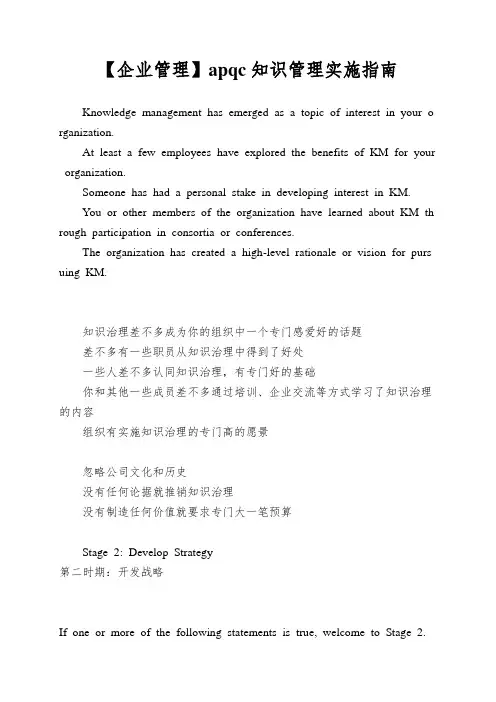
【企业管理】apqc知识管理实施指南Knowledge management has emerged as a topic of interest in your o rganization.At least a few employees have explored the benefits of KM for your organization.Someone has had a personal stake in developing interest in KM.You or other members of the organization have learned about KM th rough participation in consortia or conferences.The organization has created a high-level rationale or vision for purs uing KM.知识治理差不多成为你的组织中一个专门感爱好的话题差不多有一些职员从知识治理中得到了好处一些人差不多认同知识治理,有专门好的基础你和其他一些成员差不多通过培训、企业交流等方式学习了知识治理的内容组织有实施知识治理的专门高的愿景忽略公司文化和历史没有任何论据就推销知识治理没有制造任何价值就要求专门大一笔预算Stage 2: Develop Strategy第二时期:开发战略If one or more of the following statements is true, welcome to Stage 2.如果下面的情形有一个甚至更多跟实际相符,欢迎进入第二时期。
·Your organization has established a KM exploratory group or steering c ommittee for KM.·An executive sponsor in your organization supports further exploration o f KM.·You are looking for successful, internal grassroots efforts already under way.·Your IT organization is interested in actively supporting KM initiatives. ·You have stories of how knowledge sharing has helped your organizatio n in the past.·You have identified pilots that allow you to demonstrate how KM will benefit your organization.·You have secured ownership, funding, and buy-in for pilots.·你的组织差不多建立了KM探讨小组或者KM筹委会。
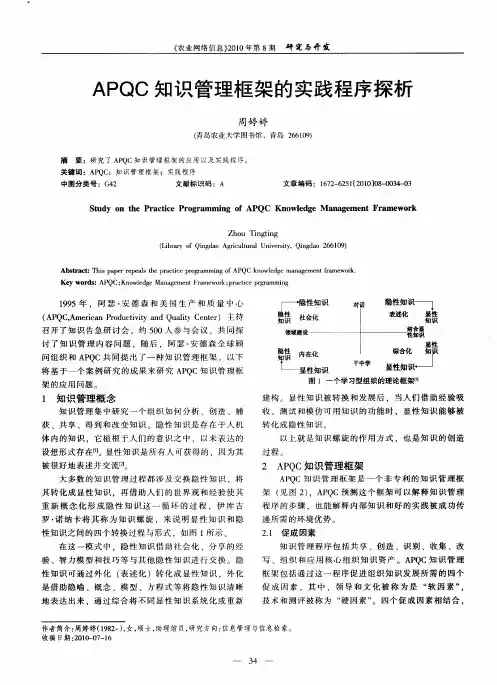
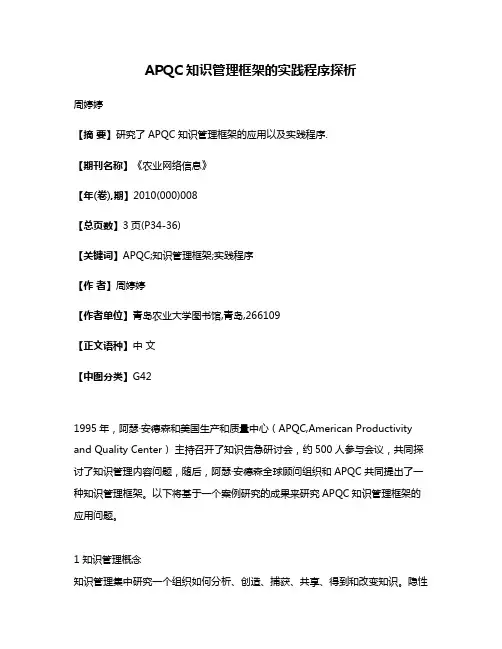
APQC知识管理框架的实践程序探析周婷婷【摘要】研究了APQC知识管理框架的应用以及实践程序.【期刊名称】《农业网络信息》【年(卷),期】2010(000)008【总页数】3页(P34-36)【关键词】APQC;知识管理框架;实践程序【作者】周婷婷【作者单位】青岛农业大学图书馆,青岛,266109【正文语种】中文【中图分类】G421995年,阿瑟·安德森和美国生产和质量中心(APQC,American Productivity and Quality Center)主持召开了知识告急研讨会,约500人参与会议,共同探讨了知识管理内容问题,随后,阿瑟·安德森全球顾问组织和APQC共同提出了一种知识管理框架。
以下将基于一个案例研究的成果来研究APQC知识管理框架的应用问题。
1 知识管理概念知识管理集中研究一个组织如何分析、创造、捕获、共享、得到和改变知识。
隐性知识是存在于人机体内的知识,它植根于人们的意识之中,以未表达的设想形式存在[1]。
显性知识是所有人可获得的,因为其被很好地表述并交流[2]。
大多数的知识管理过程都涉及交换隐性知识,将其转化成显性知识,再借助人们的世界观和经验使其重新概念化形成隐性知识这一循环的过程,伊库吉罗·诺纳卡将其称为知识螺旋,来说明显性知识和隐性知识之间的四个转换过程与形式,如图1所示。
在这一模式中,隐性知识借助社会化、分享的经验、智力模型和技巧等与其他隐性知识进行交换。
隐性知识可通过外化(表述化)转化成显性知识,外化是借助隐喻、概念、模型、方程式等将隐性知识清晰地表达出来,通过综合将不同显性知识系统化或重新建构。
显性知识被转换和发展后,当人们借助经验吸收。
测试和模仿可用知识的功能时,显性知识能够被转化成隐性知识。
以上就是知识螺旋的作用方式,也是知识的创造过程。
2 APQC知识管理框架APQC知识管理框架是一个非专利的知识管理框架(见图2),APQC预测这个框架可以解释知识管理程序的步骤,也能解释内部知识和好的实践被成功传递所需的环境优势。
apqc知识管理实施方案APQC知识管理实施方案。
知识管理是组织内部的一项重要工作,它涉及到知识的获取、存储、分享和应用。
APQC(American Productivity & Quality Center)是一个专注于知识管理和绩效改进的非营利组织,其知识管理实施方案被广泛认可和应用。
本文将介绍APQC 知识管理实施方案的基本框架和关键步骤,希望能够为您的组织的知识管理工作提供一些借鉴和帮助。
首先,APQC知识管理实施方案的基本框架包括四个关键要素,战略规划、流程设计、技术支持和文化建设。
在战略规划阶段,组织需要明确知识管理的愿景和目标,并将其与组织的战略目标相结合。
在流程设计阶段,需要建立知识的获取、存储、分享和应用的有效流程和机制。
技术支持阶段则需要选择适合组织需求的知识管理系统和工具,以支持知识管理的实施和运作。
而文化建设阶段则需要通过培训、激励和组织文化建设,营造一个有利于知识管理的组织氛围。
其次,APQC知识管理实施方案的关键步骤包括,识别知识管理的需求、制定知识管理策略、设计知识管理流程、选择知识管理技术、培训和激励员工、建立知识管理文化、监督和评估知识管理效果。
在识别知识管理的需求阶段,组织需要对当前的知识管理状况进行分析,找出存在的问题和改进的空间。
在制定知识管理策略阶段,需要将知识管理与组织的战略目标相结合,确定知识管理的重点和方向。
在设计知识管理流程阶段,需要建立知识的获取、存储、分享和应用的有效流程和机制。
在选择知识管理技术阶段,需要根据组织的需求和特点,选择适合的知识管理系统和工具。
在培训和激励员工阶段,需要为员工提供相关的知识管理培训,并建立激励机制,激发员工参与知识管理的积极性。
在建立知识管理文化阶段,需要通过组织文化建设,营造一个有利于知识管理的组织氛围。
在监督和评估知识管理效果阶段,需要建立监督和评估机制,对知识管理的实施效果进行监督和评估,及时发现问题并加以改进。
APQC知识管理实施指南APQC(American Productivity and Quality Center)是一个全球性的非营利组织,专注于帮助各类组织实施知识管理和提高其业务绩效。
APQC知识管理实施指南是APQC根据多年的实践经验和研究成果总结而成,旨在帮助组织顺利实施知识管理,并最大限度地发挥知识管理的价值。
首先,知识管理实施指南强调建立知识管理战略。
这包括制定明确的目标和愿景,确定实施知识管理的原因和动机,确保人员的共识和参与。
在制定战略时,应考虑到组织的战略目标、文化和业务需求,以确保知识管理与组织整体发展相一致。
其次,知识管理实施指南强调创建适合的组织结构和流程。
组织结构应该支持知识的共享和传递,可以通过设立知识管理部门或角色来负责知识管理的实施和维护。
同时,要建立明确的知识管理流程,包括知识的捕捉、组织、存储、共享和应用等环节。
这些流程应该与组织的业务流程相结合,提高工作效率和质量。
第三,知识管理实施指南强调培养和激励知识管理人员。
知识管理人员是知识管理实施的核心力量,应该具备相关的知识和技能。
组织可以通过提供培训和学习机会,培养员工的知识管理能力。
此外,组织还应该激励知识管理人员的积极性和创造性,例如设置奖励机制和晋升机会,以便他们更好地发挥作用。
然后,知识管理实施指南强调建立适用的技术和工具。
技术和工具是知识管理的重要支撑,可以帮助组织更好地进行知识的共享和存储。
例如,组织可以使用协作平台、文档管理系统和企业引擎等技术工具,以促进知识的共享和获取。
选择适当的技术和工具,要考虑到组织的需求、成本、安全性等因素。
最后,知识管理实施指南强调不断学习和持续改进。
知识管理是一个不断演化的过程,需要组织持续学习和改进。
组织可以通过不断的反馈和评估来了解知识管理的进展和效果,并根据反馈和评估结果进行调整和改进。
此外,组织还可以参与知识管理的专业活动和交流,从其他组织的经验中汲取启发和借鉴。
APQP 实施手册第二版APQP(Advanced Product Quality Planning,高级产品质量规划)是一种有效的质量管理方法,旨在帮助制造企业在产品开发及生产过程中达到更高的质量水平。
本文将介绍 APQP 实施手册第二版的主要内容和要求。
1. 引言APQP 实施手册第二版作为质量管理的指导文件,旨在帮助企业实施和管理 APQP 程序。
本手册以清晰明确的方式,详细说明了实施APQP 的步骤和要求,以确保产品开发和生产过程的质量满足顾客的期望。
2. APQP 实施步骤2.1 项目筹备第一步是项目筹备阶段,包括制定项目目标、确定项目团队和资源、编制项目计划等。
在这个阶段,需明确产品质量目标和项目进度要求,确保项目能够按时高质量地完成。
2.2 产品设计与开发在产品设计与开发阶段,需要进行详细的设计工作,并考虑顾客需求、功能要求、技术规范等因素。
同时,也应关注设计缺陷的预防和改进措施的制定,以确保产品质量稳定可靠。
2.3 过程设计与开发过程设计与开发是确保产品能够稳定、高质量地生产的关键。
在这个阶段,需制定合理的生产工艺流程、设备要求、作业指导书等,并进行合理的工艺验证和设备确认,以确保生产过程的可控性和稳定性。
2.4 产品验证产品验证阶段旨在确认产品设计和生产过程的可靠性和稳定性。
在此阶段,需进行样品测试和验证实验,以确保产品完全符合技术规范和客户要求。
2.5 产品制造产品制造是指在产品设计和开发的基础上,进行批量生产和交付。
在这个阶段,需实施严格的质量管理措施,包括过程监控、问题解决和可持续改善等,以确保产品质量的稳定性和满足客户的要求。
3. APQP 实施手册第二版的要求APQP 实施手册第二版对企业的要求相对严格,以确保产品的质量和客户满意度。
以下是一些主要要求:3.1 制定详细的项目计划,明确各个阶段的工作内容和时间节点。
3.2 建立有效的团队合作机制,确保项目成员之间的信息共享和沟通。
流程改进的框架经验表明,基准测试推动显着改进的潜力完全在于进行开箱即用的比较并寻找通常在行业内范式中找不到的见解。
为了实现这一有益的基准测试,APQC流程分类框架sm(PCF)作为一种高级,行业中立的企业流程模型,允许组织从跨行业的角度来看待他们的业务流程。
这个跨行业框架经历了超过15年的全球数千个组织的创造性使用。
PCF为APQC的开放标准基准sm性能指标数据库奠定了基础,这是世界上同类数据中最大的,以及全球行业领导者咨询委员会的工作。
随着数据库进一步制定定义,流程和措施,PCF将继续得到加强。
PCF,相关措施和定义可免费下载/osb。
还提供个人评估的在线基准门户。
为了获得行业内基准测试所固有的价值,APQC网站上也提供了行业特定框架。
因此,组织可以选择与特定流程改进需求最相关的框架,无论是基准测试,业务流程管理/重新设计还是内容管理。
历史流程分类框架最初被设想为业务流程的分类和APQC成员组织可以通过其共同语言对其流程进行基准测试的共同语言。
最初的设计涉及APQC和80多个组织,他们对推动美国和全球基准测试的使用非常感兴趣。
自1992年成立以来,PCF已对其大部分内容进行了更新。
这些更新使框架与组织在全球开展业务的方式保持同步。
2008年,APQC和IBM共同致力于加强跨行业的PCF,并开发了许多行业特定的流程框架。
APQC感谢各个成员组织和个人成员的贡献,他们为开发此版本的PCF以及之前的每个版本贡献了时间,内容和专业知识。
这些贡献和建议对于使框架保持最新并与全世界的企业相关至关重要。
过程配置fr amework sm运作流程1.0 > > > 发展愿景和战略2.0开发和管理产品和服务> > > 3.0市场和销售产品与服务> > > 4.0提供产品和服务> > > 5.0管理客户服务管理和支持服务7.0管理信息技术8.0管理财务资源12.0管理知识,改进和变革11.0管理外部关系10.0管理环境健康与安全(EHS)9.0获取,构建和管理财产6.0开发和管理人力资本期待APQC流程分类框架是一个不断发展的模型,APQC将继续不断加强和改进。
apqc战略管理流程下载温馨提示:该文档是我店铺精心编制而成,希望大家下载以后,能够帮助大家解决实际的问题。
文档下载后可定制随意修改,请根据实际需要进行相应的调整和使用,谢谢!并且,本店铺为大家提供各种各样类型的实用资料,如教育随笔、日记赏析、句子摘抄、古诗大全、经典美文、话题作文、工作总结、词语解析、文案摘录、其他资料等等,如想了解不同资料格式和写法,敬请关注!Download tips: This document is carefully compiled by theeditor. I hope that after you download them,they can help yousolve practical problems. The document can be customized andmodified after downloading,please adjust and use it according toactual needs, thank you!In addition, our shop provides you with various types ofpractical materials,such as educational essays, diaryappreciation,sentence excerpts,ancient poems,classic articles,topic composition,work summary,word parsing,copy excerpts,other materials and so on,want to know different data formats andwriting methods,please pay attention!APQC 战略管理流程是一个综合性的框架,用于指导组织制定和实施战略。
APQC知识治理实施指南There is a widespread understanding of the value of KM in many organizations, and one might assume that mature KM initiatives are widespread as well. However, the gap between organizations recognizing the value of KM and those fully implementing it is large.目前,专门多企业对KM都有所了解,甚至一些企业差不多认为实施KM的时机成熟了,然而,在“了解知识治理”和“实施知识治理”那个两个层次之间的距离依旧专门大的。
Establishing knowledge management strategies that will ultimately make your organization more effective can be a daunting task. Getting started down the right path is often difficult, and staying the course can be even moreso as roadblocks spring up in your way. Although you may see KM as a worthwhile effort, convincing others of its value and making it happen across your organization can be a tall order.建立知识治理的战略以保持企业的活力是一件特不困难的情况,第一步选对方向就更加困难了,整个实施过程到处充满了绊脚石。
尽管你认为知识治理是特不值得做的一件情况。
然而让其他人信服同时在组织内部广泛实施是一个特不艰巨的任务。
APQC*s approach to KM implementation eases your way, even as your organization may be struggling to understand the issues, tactics, and tools necessary for a successful KM journey. Our Road Map to Knowledge Management Results: Stages of ImplementationTM framework helps you navigate toward true institutionalization by laying out the characteristics, requirements, and action steps of every stage of KM implementation:APQC的这套实施方法能够关心你更好的解决问题,即使你的企业可能正在困难的寻求概念上的理解、战术的制定以及工具的使用去成功地实施知识治理。
为此APQC提供了这份实施指南,通过时期特征的描述,需求分析以及实施步骤等内容来关心你成功的找到实施质是治理的正确方向,事实上施过程分成了以下5个部分。
Stage 1: Get StartedStage 2: Develop a StrategyStage 3: Design and Launch a KM InitiativeStage 4: Expand and SupportStage 5: Institutionalize Knowledge Management第一时期:启动第二时期:策略开发第三时期:试点第四时期:推广和支持第五时期:将知识治理制度化Based on APQC*s study of and collaboration with best practice organizations over a period of years, APQC*s Road Map to Knowledge Management Results: Stages of ImplementationTM framework spells out the essential steps to achieve true knowledge management implementation. A synthesis of our experience with early adopters, assessment of emerging trends, and identification of best practices, this model serves as a navigation tool for organizations that have seen the glimmer of opportunity in KM to efficiently develop new products, beat the competition, motivate team members, and maximize profits and investments.依照APQC多年的在最佳实践基础上的研究和总结,这份实施指南讲明了成功知识治理实施时期中的关键步骤。
我们将先前实施者的经历、行业进展的最新趋势以及最佳实践的经验综合在一起,作为指南关心企业成功实施知识治理,这些企业差不多看到了实施知识治理所带来的机会,促进企业开发新产品,战胜竞争对手,激励团队成员,以及使利润和收益最大化。
Each stage involves description of provoking events, objectives, key players and roles, governance and structure, information technology impact, the nature of business cases, measurement approaches, and budget issues. By completing the key activities for each stage, your organization will maintain sound footing throughout the entire KM implementation process.在APQC多年来对专门多优秀的企业的研究和合作的基础上,这份实施指南详细描述了知识治理实施的几个时期。
每个时期都包含有导火索、目标、治理和构架、信息技术、案例、衡量方法和预算以及完成每个时期的关键活动,你的企业将在知识治理实施的过程中不断的提高。
Stage 1: Get Started第一时期:启动Learning where you are is the first important task along your path to knowledge management success. APQC shows you where to start and points you in the right direction.认清现状是成功实施知识治理的首要任务,那个指南为你指出应该从哪里入手以及正确的方向。
If one or more of the following statements is true, your organization is likely ready to embark on Stage 1 of the journey.假如下面所列的情况有一个是属于事实的,那么你的组织差不多做好的预备,请进入知识治理第一时期。
•Knowledge management has emerged as a topic of interest in your organization.•At least a few employees have explored the benefits of KM for your organization.•Someone has had a personal stake in developing interest in KM.•You or other members of the organization have learned about KM through participation in consortia or conferences.•The organization has created a high-level rationale or vision for pursuing KM.•知识治理差不多成为你的组织中一个特不感兴趣的话题•差不多有一些职员从知识治理中得到了好处•一些人差不多认同知识治理,有专门好的基础•你和其他一些成员差不多通过培训、企业交流等方式学习了知识治理的内容•组织有实施知识治理的专门高的愿景第一时期的关键活动KEY ACTIVITIES FOR STAGE 1So, what now? you might wonder. Fortunately, APQC has been here before with dozens of world-class companies and knows what it takes to initiate this complex process. Based on the organization*s wealth of experience, APQC has summarized the key activities, as well as some helpful hints, of Stage 1.As an insightful innovator and early promoter of KM, your tasks at this exciting stage are to define KM for others in your organization, share stories of how KM has helped other successful companies, and align KM use with current initiatives.你可能会想:讲了这么多,现在我该做什么?专门幸运,APQC跟世界顶级的大公司差不多经历了那个过程,同时明白应该如何样开始那个复杂的过程。